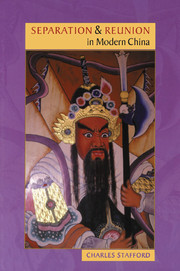Book contents
- Frontmatter
- Contents
- Acknowledgements
- Introduction: an anthropology of separation
- 1 Two festivals of reunion
- 2 The etiquette of parting and return
- 3 Greeting and sending-off the dead
- 4 The ambivalent threshold
- 5 Commensality as reunion
- 6 Women and the obligation to return
- 7 Developing a sense of history
- 8 Classical narratives of separation and reunion
- 9 The politics of separation and reunion in China and Taiwan
- Conclusion: the separation constraint
- Notes
- References
- Index
9 - The politics of separation and reunion in China and Taiwan
Published online by Cambridge University Press: 22 September 2009
- Frontmatter
- Contents
- Acknowledgements
- Introduction: an anthropology of separation
- 1 Two festivals of reunion
- 2 The etiquette of parting and return
- 3 Greeting and sending-off the dead
- 4 The ambivalent threshold
- 5 Commensality as reunion
- 6 Women and the obligation to return
- 7 Developing a sense of history
- 8 Classical narratives of separation and reunion
- 9 The politics of separation and reunion in China and Taiwan
- Conclusion: the separation constraint
- Notes
- References
- Index
Summary
After a long period of unity, the empire must divide; and after a long period of division, the empire must unite (tianxia shi hejiu bifen; fenjiu bihe).
Opening line of San Guo (The Romance of the Three Kingdoms)More than 1200 years ago, the Chinese poet Tu Fu used separation from an exiled friend as an emotion-laden metaphor for the problems of the Tang dynasty. But the resulting verse is far from unique. On the contrary, Chinese poets have routinely used emotive personal metaphors to discuss the politics of the day. In Bourdieu's terms, the analogies must seem ‘irresistible’, and modern Chinese narratives of national unity have also often drawn on the same and similar metaphors. In this chapter, I will suggest that the idioms of separation and reunion make for especially seductive political rhetoric in modern China and Taiwan, where they have many personal associations, and therefore a kind of natural legitimacy. But I will also hope to show that this seductive – or ‘enchanting’ – rhetoric has its limitations in history. This is so, first of all, because many people can be shown to have resisted its charms, i.e. they have ‘gone away’, in various senses, in spite of it. (Indeed, it can be argued that the separation/reunion matrix actually facilitates certain kinds of separation rather than making them more difficult.)
- Type
- Chapter
- Information
- Separation and Reunion in Modern China , pp. 156 - 173Publisher: Cambridge University PressPrint publication year: 2000



